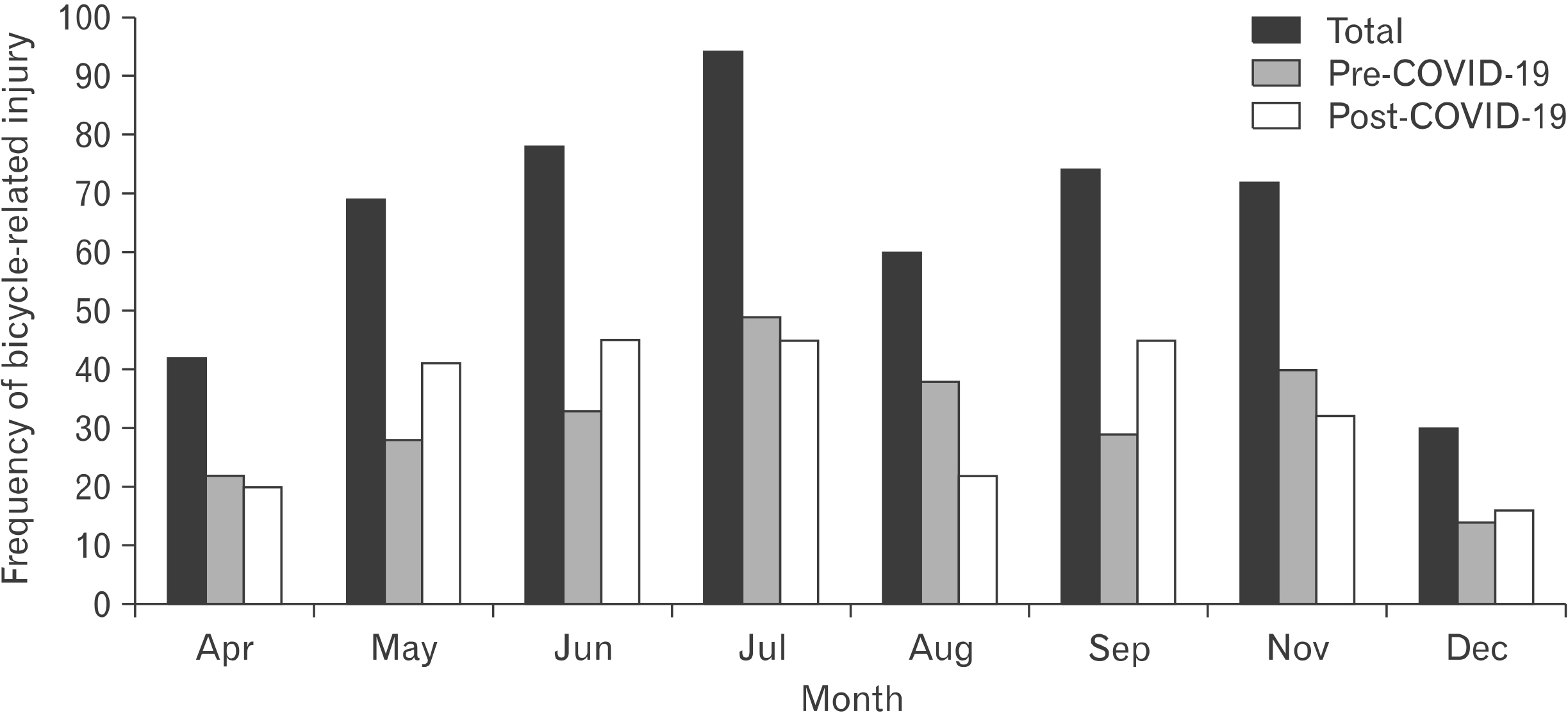Korean J Sports Med.
2021 Sep;39(3):110-116. 10.5763/kjsm.2021.39.3.110.
Epidemiological Characteristics of Bicycle-related Injuries with the Emergence of the COVID-19
- Affiliations
-
- 1Department of Orthopedic Surgery, Myongji Hospital, Hanyang University College of Medicine, Goyang, Korea
- KMID: 2519573
- DOI: http://doi.org/10.5763/kjsm.2021.39.3.110
Abstract
- Purpose
Following the outbreak and global spread of the coronavirus disease 2019 (COVID-19), an increasing number of people have turned to cycling. This study aims to investigate the epidemiology of bicycle-related injuries before and after the emergence of the COVID-19.
Methods
In this retrospective study, we collected medical records of those patients who visited the emergency room for orthopedic injuries related to bicycle accidents. The “COVID-19 period” consisted of the patients identified from April 1 to November 31 in the year 2020, while the “pre-COVID-19 period” consisted of those identified during the same months of the year 2019.
Results
A total of 519 patients were identified. The bicycle-related injuries increased by 5.1% during the COVID-19, in comparison to the pre-COVID-19 period. Among these, 76.3% were men. The highest incidence of the injuries was seen for 10– 19 years of age during the pre-COVID-19, and for 50– 59 years of age during the COVID-19 period. Overall, upper limb injuries were the commonest, consisting of 32.2% of all injuries. The shoulder injuries were the commonest in the pre-COVID-19, while the knee injuries were the commonest in the COVID-19 period. Assessing the severity of the injuries, contusion (81.8%) was the commonest. Of the injuries requiring hospital admissions, hip injuries had the highest incidence at 76.5%.
Conclusion
During the COVID-19, the total number of bicycle-related injuries did not increase significantly. In the bicycle-related injuries, the middle-age group had the highest proportion during the COVID-19 period. More efficient prevention strategies for middle-aged riders are necessary.
Figure
Reference
-
1. Sedaily. c2021. Big two bicycle companies sale rebound in COVID-19 [Internet]. Sedaily;Seoul, KR: Available from: https://www.sedaily.com/NewsView/22IEVY1P66. cited 2021 Feb 5.2. UPI News. c2020. Seoul will build 23.3 km bike lanes including Hangang-daero [Internet]. UPI news;Seoul, KR: Available from: https://www.upinews.kr/newsView/upi202006150073. cited 2020 Jun 15.3. Seoul Metropolitan Public Data Information. c2021. Public bike utilization status of Seoul City [Internet]. Seoul Metropolitan Public Data Information;Seoul, KR: Available from: http://data.seoul.go.kr/dataList/OA-14994/F/1/datasetView.do#. cited 2021 Feb 22.4. Ministry of the Interior and Safety. c2020. 2019 Status of bicycle usage [Internet]. Ministry of the Interior and Safety;Sejong, KR: Available from: https://www.mois.go.kr/frt/bbs/type001/commonSelectBoardArticle.do?bbsId=BBSMSTR_000000000014&nttId=80093. cited 2020 Sep 23.5. Traffic Accident Analysis System. c2020. Traffic accident statistics 2020 [Internet]. Traffic Accident Analysis System;Wonju, KR: Available from: http://taas.koroad.or.kr/web/shp/ine/initTaas.do. cited 2020 Aug 27.6. Heo YM, Yi JW, Oh BH, Jun JB, Cho HJ, Kim TG. 2018; Study on the orthopedic characteristics of bicycle injury patients. Korean J Sports Med. 36:1–6. DOI: 10.5763/kjsm.2018.36.1.1.
Article7. Kim BI, Jung JH, Jung KY. 2009; The epidemiology of bicycle injury in Korea: patients who visited 55 emergency rooms. J Korean Soc Traumatol. 22:128–33.8. Chen WS, Dunn RY, Chen AJ, Linakis JG. 2013; Epidemiology of nonfatal bicycle injuries presenting to United States emergency departments, 2001-2008. Acad Emerg Med. 20:570–5. DOI: 10.1111/acem.12146. PMID: 23758303.
Article9. Eilert-Petersson E, Schelp L. 1997; An epidemiological study of bicycle-related injuries. Accid Anal Prev. 29:363–72. DOI: 10.1016/S0001-4575(97)00002-X. PMID: 9183474.
Article10. Court-Brown CM, Allan M, Davidson E, McQueen MM. 2013; The epidemiology of cycling fractures in adults. Emerg Med. 3:139.11. Lizaur-Utrilla A, Martinez-Mendez D, Collados-Maestre I, Miralles-Munoz FA, Marco-Gomez L, Lopez-Prats FA. 2016; Early surgery within 2 days for hip fracture is not reliable as healthcare quality indicator. Injury. 47:1530–5. DOI: 10.1016/j.injury.2016.04.040. PMID: 27168082.
Article12. Aprato A, Bechis M, Buzzone M, Bistolfi A, Daghino W, Masse A. 2020; No rest for elderly femur fracture patients: early surgery and early ambulation decrease mortality. J Orthop Traumatol. 21:12. DOI: 10.1186/s10195-020-00550-y. PMID: 32862297. PMCID: PMC7456623.
Article
- Full Text Links
- Actions
-
Cited
- CITED
-
- Close
- Share
- Similar articles
-
- Clinical implications of coronavirus disease 2019 in neonates
- The epidemiologic characteristics of dog-bite injury during COVID-19 pandemic in Korea
- A Chinese Case of Coronavirus Disease 2019 (COVID-19) Did Not Show Infectivity During the Incubation Period: Based on an Epidemiological Survey
- Transition of COVID-19 to endemic phase and emergence of COVID-19 related neuropathic pain
- Comparison of pediatric injury patterns before and during the COVID-19 pandemic in Korea: a retrospective study



